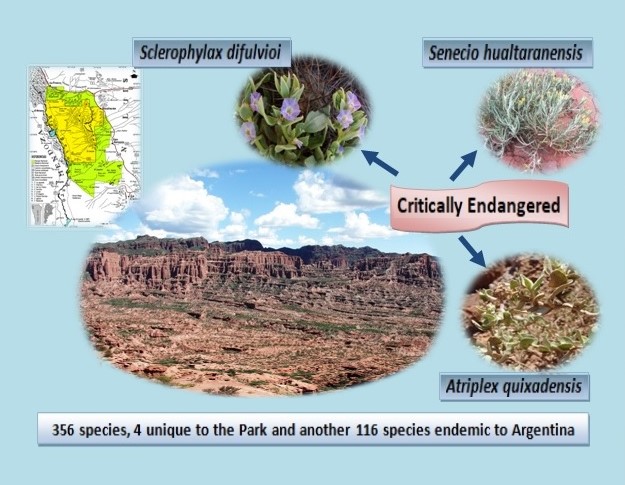Diversity and conservational status of vascular plants of "Sierra de las Quijadas" National Park (San Luis, Argentina)
Palabras clave:
Argentina, Bioformas, Conservación, Flora vascular, Parques nacionales, San Luis, Sierra de las QuijadasResumen

The "Sierra de las Quijadas" National Park, located in the NW of San Luis province, covers 150,252 hectares and preserves a sample of the Chaco-Monte ecotone, with communities of the "Dry Chaco", and "Monte" ecoregions (partly "Monte of plains and plateaus" and partly "Monte of Sierras and bolsons"). It includes mixed forests, shrubby steppes, groves and galleries, rings of halophytes, "pajonales" and rushes. Our goals were to inventory and analyze the vascular flora as well as to identify the endemisms that require greater protection. We recorded 356 species distributed in 208 genera of 58 plant families. Eight taxa are new records for the native vascular flora of the province of San Luis. While 120 taxa are endemic to Argentina, four species turned out to be exclusive of the Park and surroundings: Atriplex quixadensis (Chenopodiaceae), Senecio hualtaranensis (Asteraceae), Sclerophylax difulvioi (Solanaceae) and Gomphrena colosacana var. andersonii (Amaranthaceae). These taxa suffer varying degrees of threat from population restriction, intense erosion and anthropic action: 3 are critically endangered (CR), other 3 are endangered (EN), 10 are vulnerable (VU), 25 near threatened (NT) and 79 cause minor concern (LC), requiring in many cases immediate and continued protection. Dicotyledons (74%) and Monocotyledons (25%) predominate, plus 2 Monilophyta species and 3 Gymnospermae. The six best represented families are Poaceae, Asteraceae, Fabaceae, Solanaceae, Verbenaceae and Bromeliaceae, which account for 56% of the species. Phanerophytes and Hemicryptophytes life-forms reach 24% each, followed by Chamaephytes (22%) and Therophytes (16%). This reveals a remarkable adaptation of the flora to the long dry season.
Highlights
- A first check-list of the vascular flora of the Sierra de las Quijadas National Park is presented, in the ecotone Dry Chaco and Monte, one of the most arid places in Argentina.
- The Park preserves 356 species and 99 infraspecific taxa (3.6% of the Argentinean flora). Eight of them are new records for the province of San Luis.
- Stand out 4 species that are unique to the Park, of which 3 are critically endangered (CR) and the remaining one is vulnerable (VU).
- Another 116 species are endemic to Argentina, including 3 endangered (EN), 9 vulnerable (VU), and 25 almost threatened (NT) with extinction.
- The prevalence of chamaephytes, hemicryptophytes, cryptophytes and therophytes (70%) reveal the high degree of adaptation to the prolonged dry season.
Descargas

Descargas
Publicado
Cómo citar
Número
Sección
Licencia
Aquellos autores/as que tengan publicaciones con esta revista, aceptan las Políticas Editoriales.










.jpg)




